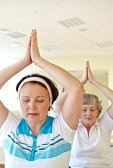Regular exercise is a major component of a healthy lifestyle.
 Unfortunately, we are less active than previous generations were, partially due to our improved lifestyles.
Unfortunately, we are less active than previous generations were, partially due to our improved lifestyles.
Studies show that many adults sit down for more than seven hours a day.
People older than 65 are the most sedentary age group, spending at least 10 hours lying or sitting down. Age causes the body to slow down but this is not a valid reason to avoid exercise.
The Cost of Inactivity
The Department of health calls inactivity a “silent killer.” There is evidence that long periods of sitting or lying down and other sedentary behavior is detrimental to health. Exercise can reduce risk of diabetes, stroke, cancer, heart disease, and other major illnesses by up to 50 percent and reduce risk of an early death by as much as 30 percent.
It can also reduce risk of depression, stress, Alzheimer’s disease, and dementia. Mood, self-esteem, energy, and quality of sleep improve with physical activity. Exercise is a miracle cure that is easy to administer and does not cost any money.
Exercising During the Senior Years
Elderly people tend to worry that their bodies cannot handle exercise. The truth is that lack of physical activity can make their bodies frail so elderly individuals should exercise to prevent this from happening.
Regular physical activity can delay or prevent the onset of many age-related health conditions, allowing people to look and feel better for a longer period. Those with term life insurance may even outlive their policies!
outlive their policies!
Older adults who do not have mobility-limiting health conditions and are fit should engage in muscle-strengthening and aerobic activities on a weekly basis. In terms of amount, 2 ½ hours of fast walking, cycling, or other aerobic activity of moderate intensity and at least two days of muscle-strengthening activities that work all of the major muscle groups are sufficient.
Muscle-strengthening exercises should focus on the back, legs, abdomen, hips, arms, shoulders, and chest.
For most people, fast walking, water aerobics, canoeing, pushing a lawn mower, and playing doubles tennis require moderate effort. These activities increase heart rate and cause people to feel warmer and breathe faster.
Even cooking, housework, and shopping count as moderate-intensity activity. In general, if you can talk but not sing a song, the exercise is of moderate intensity.
Those who prefer aerobic activity of vigorous intensity should engage in an hour and 15 minutes of this each week and perform muscle-strengthening activities at least two days a week. A game of singles tennis, running, uphill hiking, riding a bike quickly, and martial arts are examples of vigorous-intensity aerobic activity.
The heart rate increases substantially, you breathe fast and hard, and you must pause for a breath after saying a few words.
Approximately 75 minutes of vigorous-intensity activity can provide health benefits similar to those achieved from 150 minutes of moderate-intensity activity. Aerobic activity of moderate and vigorous intensity can also be combined in an equivalent mix and supplemented by muscle-strengthening activities.
For each exercise that strengthens muscles, perform eight to 12 repetitions and do at least one set of these.
